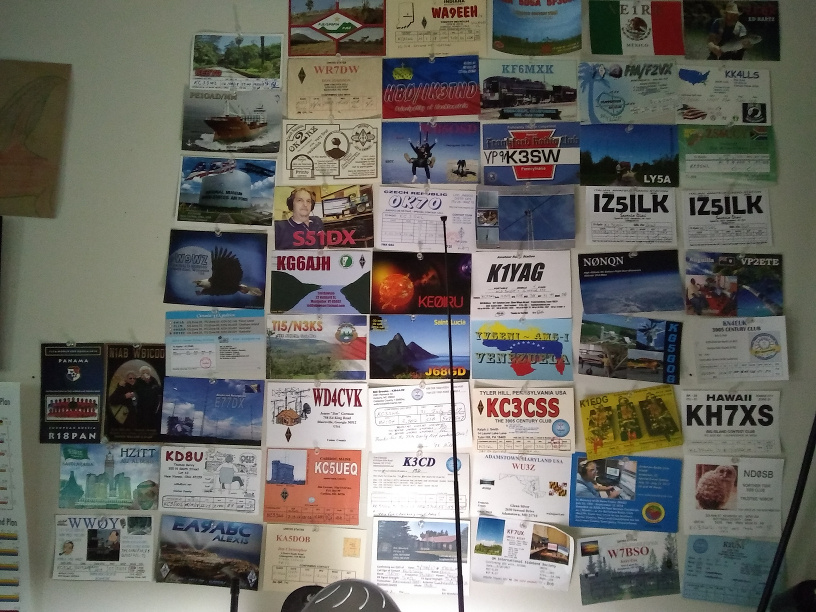Hi and welcome to my new updated page.This should be updated more frequently now as I have had a few changes around here. Listen for my callsign KC3SWL on either HF or 2 meters.
I have a basic station setup for now , being in an apartment does have it's disadvantages.However, I have managed to overcome some obstacles and was able to put up an outside antenna or two for my VHF work and my HF work. I use a Comet GP1 144/440 fiberglass antenna at 31 feet elevation and a homemade 135 ft off center fed dipole at 31 ft. Both are mounted to a mast made of 3 10.5 ft sections of 1 3\8 diameter chain link top rail.The 50 foot pine tree I had used before was taken out by a tornado recently.
Click on the handheld radio to visit Ham Radio Outlet's Alinco page.
Click on the Kenwood to go to Universal Radio's Kenwood TS430 page.
The Kenwood TS430s has two filters of 1.8 khz and 2.4 khz for SSB and a 6 khz filter for AM listening along with a 500 hz filter for CW or Morse Code and RTTY. The overall quality is outstanding .The receive section has some outstanding characteristics.It has a very low signal receive capability for digging out those weak stations. One night with some local noise being about a S3 I was still able to pull in 3 or 4 South American stations on the 60 meter band and heard them clearly.I had been using my Ten-Tec RX320 and I never heard them in the past few months.That's a nice receive section. Tuning on the ham radio bands for instance I have heard stations from Western Australia working a station in Spain on 40 meters. One of my more memorable contacts was listening to two amateur radio operators in Kuwait talking to each other before one of them called for North American stations. This was heard under two stateside amateur radio operators talking for what seemed like hours about various settings on their Icom radios to make them sound louder. After the stateside guys went quiet I was able to work one of the Kuwaiti stations ,Osama,9K2OD in Kuwait City. After that experience I had a newfound respect for those engineers at Kenwood that designed this radio Some of the other weak signal stations I have been able to work are E77DX from Bosnia-Hercegovina, CE3YG from Chile and ZS3D from South Africa. On transmit I am now using a Behringer XM8500 dynamic cardoid microphone as the main microphone, putting the MC43s hand microphone to reserve status.I have received some good audio reports using this set up from stations both nearby as well as overseas. The Kenwood TS430 is an older radio from the mid to late 80's. It's an easy radio to operate, all buttons have one function as opposed to the menu driven radios of today. To see my most recent contacts just look below.
The Alinco is a simple to operate hand held transceiver for the higher bands for local and nominal distance communications.The manual is straightforward and I had it programmed within a few minutes using data from the repeater book.,The audio is nice and strong and the output is awesome for it's price. I usually get good reports on it and a late night QSO or conversation is easy to do with other hams from the PA MD DE area.
For base VHF operation I now have a older model radio from Kenwood. The TM2550A is a 45 watt mono-band VHF transceiver and the radio is really rock solid.It's built like a tank and is not a light plastic rig like some built today. The receive on the radio is very good ,even better than my Kenwood TM281 I have mobile. I have been through a few radios looking for a base radio that would hold up to the urban area signal saturation and this radio seems to have fit the bill. I am able to work repeaters 45 miles away with my current antenna being a Comet GP1.
Click on the TM2550A to go to Universal Radio's page on this radio.
For mobile operations I use the Kenwood TM281A 2 meter mobile radio. When combined with a Diamond 5\8 wave antenna on the back hatch of the new ride, my Chevrolet Equinox, it tends to work great around town on the local and not so local repeaters as well as point to point with other hams.Click on the pic to get to the Universal Radio page for this radio.
My antenna is mounted to the back hatch to avoid drilling holes in the sheet metal or using mag mounts which tend to rust out and cause moisture issues in the coax feed to the radio.
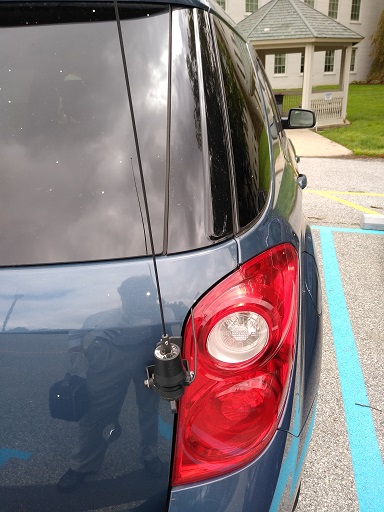
This is my first home-made dual band antenna. I used some solid copper wire of two different diameters to create the 2 meter/440 mhz antenna elements mounted on a wooden base.It worked great til the wind tore it apart one day. I got tired of repairing it and got a commercially made antenna.
Back in October of 2018, a ham friend called me up while I was on my way home and asked me if I wanted a radio. He didn't say much about it just what kind it was and he had bought it a long time ago and it was sitting around not being used. He thought about my minimal station and knew I would put the radio to good use and so I became a Kenwood TS870 owner complete with matching power supply and speaker..Click on the pic below to go see it at Universal Radio in Ohio.
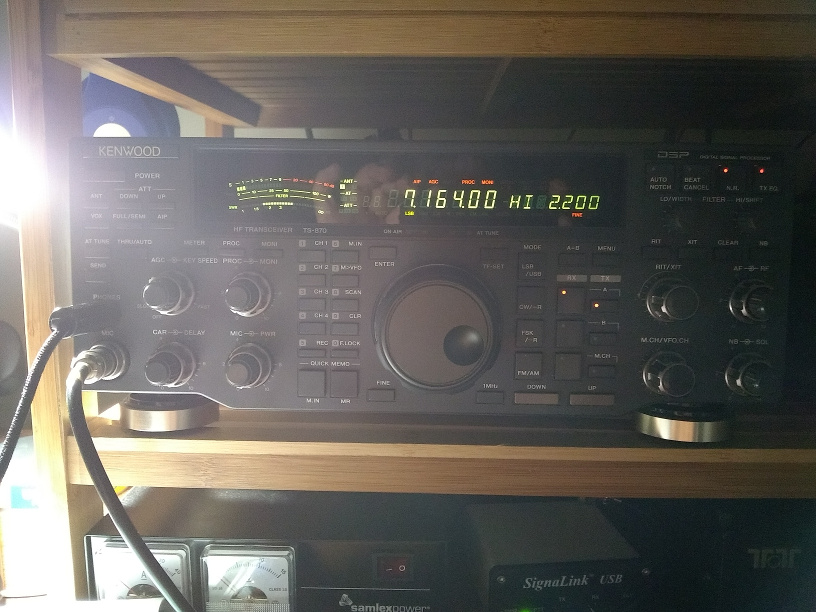
So as far as the new radio goes? How does it work? Do I like it? I have to say at this point I love it.I never thought I would have a radio of this quality or caliber sitting on MY desk. It is simply amazing how well it works.The radio has DSP in the IF section and not just in the audio section which means I can tailor the bandwidth with cutoff ranges not achievable before using just crystal filters to suit my particular need .The receive section is phenomenal. I thought the TS430 had a good receive, but this radio blows that out of the water.On the transmit side I can tailor the audio to punch through the noise or sound like an AM broadcaster it's just that good.The radio has general coverage receive and it works exceptionally well on the shortwave broadcast bands. Overall, using the radio is a great experience. The audio coming out of the SP31 speaker that came with the rig sounds absolutely clear and is not tiring to the ears as some radios can be after an extended time.I use Kenwood HS5 headphones and I can pick out stations way down in the noise floor and with a little tweaking I can actually make a contact. Working stations with a signal report of 5\1 meaning no interference and signal meter reading s 1 are not impossible anymore.I have received several unsolicited reports about the outstanding audio coming out of the radio from radio operators around the bands.
This is my station as it sits today. Everything I need in one spot.
Some of the equipment used are the Kenwood radios along with a Drake W4 meter, Dentron SuperTuner, Timewave ANC-4 Noise Canceller, Kenwood PS52, Samlex 35 amp power supply, PRA 80 watt VHF amplifier, RigExperts AA35 Zoom Antenna Analyzer, homebrew field strength meter, Vectronics 300 watt dummy load, Revex 200 watt VHF/UHF meter, Alinco DJ500 VHF/UHF handheld radio, Ten Tec RX320 and SDRplay RSP1A SDR radio. I use a Shure SM58 , a Behringer XM8500 , Kenwood MC60 and a Kenwood MC43s for microphones on the various radios.For RTTY and other digital modes there is the SignaLink USB.For VHF/UHF receiving there is a Realistic Pro2015 and Realistic Pro 2004 scanning recievers.
An average time at the controls of the station might have my computer screen looking like this.
I can use both the TS870 and the RX320 from the computer controlling tuning and volume and band and mode selection.
A new addition to the radio shack is Cheeto, a rescue kitty from Cecil County Animal Services. We got him when he was 2 months old and and he looked like a little skinny Cheeto snack. He was the runt of the litter ,apparently not any more since he weighs about 15 pounds or more now.
A note of interest to those amateur radio operators and SWL's that have to fight off a lot of noise on the shortwave broadcast or amateur bands.This may be old news to some ,however I just recently acquired a Timewave ANC-4 Antenna Noise Canceller. I have to say I'm seriously impressed by how this device works.It takes a sample of the area noise through a separate noise antenna and phases it out 180 degrees to null the noise while keeping the desired signal. With noise levels up to 40 db over S9 which is almost completely swamping the receiver and wiping out almost all signals, this device can knock that noise down to a more manageable S7 to S8 if not more depending on the antenna placement and orientation.On the lower bands such as 40 meters or 80 meters this can make the difference between hearing a station and not even knowing they are there. I have worked more stations with a signal of s3 to s5 than I ever have before.This is not a paid endorsement or a trick or some sort of scam. This device really does work. It does have a learning curve but by experimenting with various antenna lengths and vertical versus horizontal orientation, as well as varying the controls such as antenna noise and phase range and frequency range, you will be surprised at the results. I know I was.
Since I started in shortwave a long time ago, I always wanted to be on the hf bands and VHF\UHF as well. With the legacy code requirements of 13 wpm for a general class license , my ears couldn't ever get the right CW ability down pat.I missed the Novice code requirement by at least 3 words per minute with only a 5 word per minute requirement,I was that bad at trying to copy Morse Code.Now they just ask a lot more technical questions and the question pool is quite large. For the Technicians Class Amateur Radio license there is a pool of 426 questions on a 35 question test. To upgrade to General Class license there were 462 possible questions to make up the 35 question test. For Extra Class a total of 50 questions is drawn from a pool of 712 possible questions.
I had to take my test three times before passing the Technician Class exam.Each time there was a couple of three kicker questions that threw me off, but I was finally able to pass in March of 2017. On Field Day 2017 at the end of May, I upgraded to General . Working on the ham bands with a General class licence was fun ,however I was missing lots of much harder to find countries on the bands. On March 3 of 2018 I sat for my Extra class license test and succeeded !!
When I was interested in getting back into the radio hobby these guys were around to help out. The State Line Radio Club has members in Pennsylvania, Delaware and Maryland. They meet at the American Legion in Rising Sun Maryland the first Saturday of alternating months to hold VE Amateur Radio exams.On the third Saturday of each month they meet at the Post House restaurant in Nottingham,PA for the monthly breakfast club meeting.

This is our 2019 Field Day operation in action,I am in the foreground working ham radio stations on the 20 meter band using my Kenwood TS430 and a inverted V antenna.
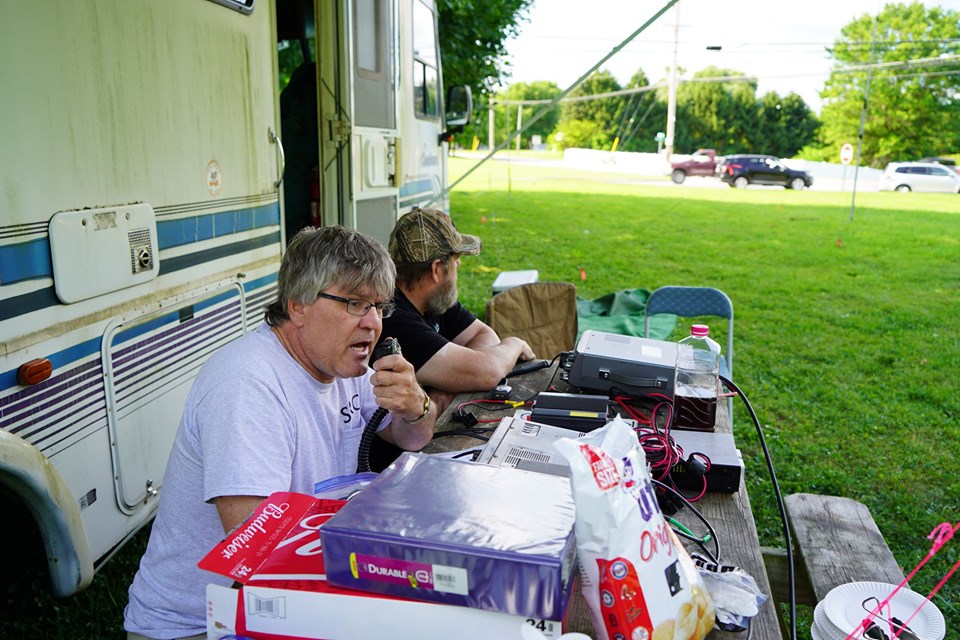
Since I got my Technicians license, I have worked at last count 143 countries with 130 being confirmed,either by electronic log or paper QSL card. I have managed to work Europe,Asia,Africa,South America and Oceania along with North America so far.
I just realised I qualified for this award a awhile ago after looking at my logs and so I put in for it .
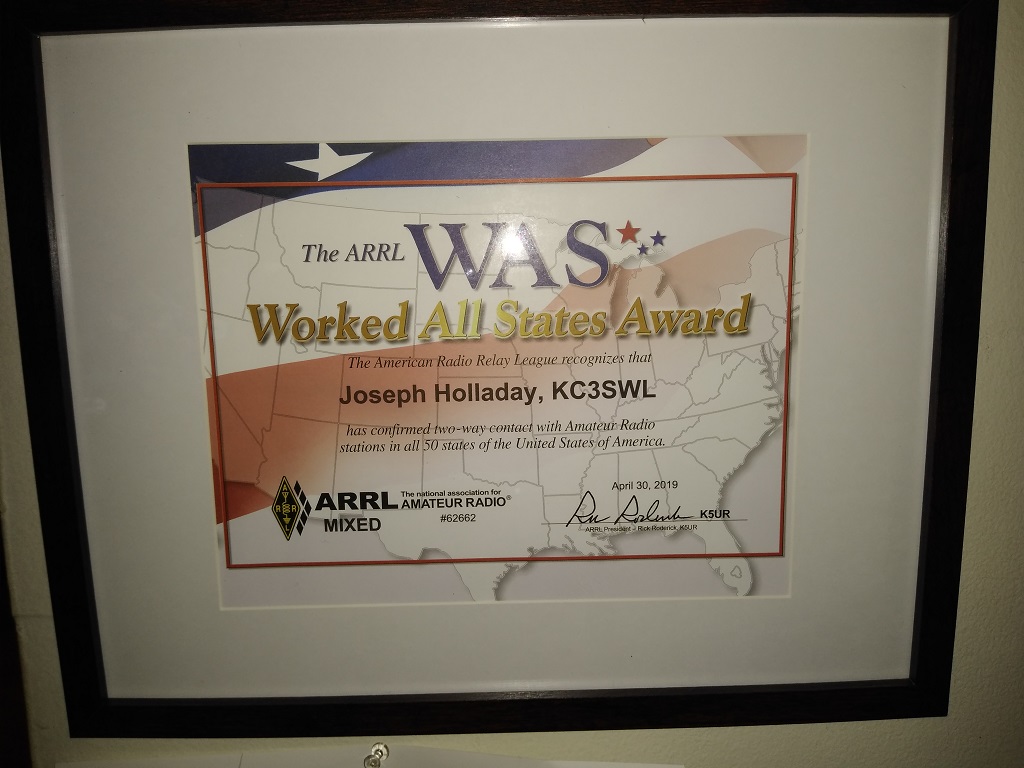
It took me just about 2 years to work on this from my first overseas contact to Lou YV5ENI in Venezuela until I received confirmation of my 100th country, but I finally made it.This is the award you can get when you have 100 countries confirmed .
My alltime favorite stations that I have worked would have to be Michel,PE10AD Maritime Mobile and Thomas,WB5VIS Aeronautical Mobile.Both contacts were awesome to work and hold a QSO for a little while. The Aeronautical Mobile was a Boeing 757 flying over Minnesota at the time.The Maritime Mobile was a freighter 400 miles off Halifax Canada en route to the Port of Baltimore. So far, I have managed to contact stations on all the major continents and several islands in both the Atlantic and Pacific oceans.From Asia to South America and over to South Africa and the Mid-East I have had fun making contacts and new friends on the air.
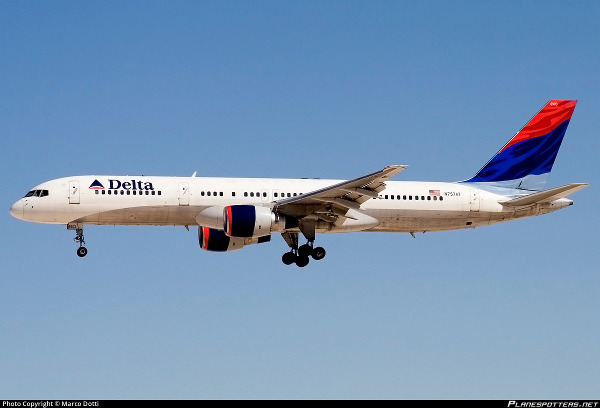
A recent snapshot of me at the controls of KC3SWL home station
At the moment my outside antenna farm is sparse but apartment living does have it's challenges.Check back for more info on my new part of the radio hobby.
Here are a few of the QSL cards I have received through the postal service, with a lot more through electronic QSL services..
